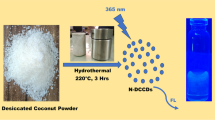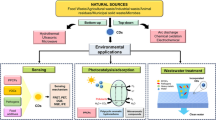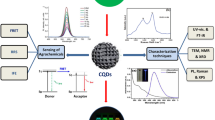Abstract
An adept, rapid and novel water-soluble glutathione functionalized CdS quantum dots (GSH@CdS QDs) were fabricated using green pathway for sensing of heavy metal contamination prevalent in industrial wastewater. GSH@CdS QDs were facilely synthesized in an aqueous phase reaction and were effectively characterized using FT-IR, XRD, FESEM, HRTEM and EDX techniques. The distinct fluorescence characteristics of GSH@CdS QDs were explored and the QDs showed selective sensitivity towards mercury ions with a low limit of detection of 0.54 nM under optimal conditions. The detailed interaction between GSH@CdS QDs and Hg2+ and the probable fluorescence quenching mechanism were established in this study. In comparison to already reported fluorescent probes, GSH@CdS QDs showed high sensitivity, biocompatibility, long fluorescence stability and convenient removal of mercury ions.

Facile green route for the fabrication of glutathione capped CdS quantum dots for fluorescence-based detection of toxic Hg2+ ions.










Similar content being viewed by others
Data Availability
Not applicable.
References
Schiffman JD, Balakrishna RG (2018) Quantum dots as fluorescent probes: synthesis, surface chemistry, energy transfer mechanisms, and applications. Sensors Actuators B Chem 258:1191–1214. https://doi.org/10.1016/j.snb.2017.11.189
Ramalingam G, Saravanan KV, Vizhi TK, Rajkumar M, Baskar K (2018) Synthesis of water-soluble and bio-taggable CdSe@ZnS quantum dots. RSC Adv 8:8516–8527. https://doi.org/10.1039/C7RA13400B
Huy BT, Phuong NTK, Nguyen TT, Lee YI (2018) Photoluminescence spectroscopy of Cd-based quantum dots for optosensing biochemical molecules. Appl Spectrosc Rev 53:313–332. https://doi.org/10.1080/05704928.2017.1309424
Gong T, Liu J, Liu X, Liu J, Xiang J, Wu Y (2016) A sensitive and selective sensing platform based on CdTe QDs in the presence of L-cysteine for detection of silver, mercury and copper ions in water and various drinks. Food Chem 213:306–312. https://doi.org/10.1016/j.foodchem.2016.06.091
Matea CT, Mocan T, Tabaran F, Pop T, Mosteanu O, Puia C, Lancu C, Mocan L (2017) Quantum dots in imaging, drug delivery and sensor applications. Int J Nanomedicine 12:5421–5431. https://doi.org/10.2147/IJN.S138624
Luo G, Shen K, Wu X, Zheng J, Xu C (2017) High contrast photoelectrochromic device with CdS quantum dot sensitized photoanode. New J Chem 41(2):579–587. https://doi.org/10.1039/C6NJ02756C
Brahim NB, Mohamed NB, Chaabane RB, Haouari M, Ouada HB, Negrerie M (2017) Interaction of l-cysteine functionalized CdSe quantum dots with metallic cations and selective binding of cobalt in water probed by fluorescence. Sensors Actuators B Chem 243:489–499. https://doi.org/10.1016/j.snb.2016.12.003
Wang Z, Xing X, Yang Y, Zhao R, Zou T, Wang Z, Wang Y (2018) One-step hydrothermal synthesis of thioglycolic acid capped CdS quantum dots as fluorescence determination of cobalt ion. Sci Rep 8(1):8953. https://doi.org/10.1038/s41598-018-27244-0
Espinosa LM, Aucelio RQ, Silva AR, Gramatges AP (2018) Role of a cationic surfactant in mediating interaction of flavonoids with 3-mercaptopropanoic acid capped CdTe quantum dots (3MPA-CdTe QDs). Colloids Surf A 553:195–202. https://doi.org/10.1016/j.colsurfa.2018.05.051
Singh A, Guleria A, Kunwar A, Neogy S, Rath MC (2017) Saccharide capped CdSe quantum dots grown via electron beam irradiation. Mater Chem Phys 199:609–615. https://doi.org/10.1016/j.matchemphys.2017.07.062
Brahim NB, Poggi ML, Lambry JC, Mohamed NBH, Chaabane RB, Negrerie M (2018) Density of grafted chains in thioglycerol-capped CdS quantum dots determines their interaction with aluminium (III) in water. Inorg Chem 57:4979–4988. https://doi.org/10.1021/acs.inorgchem.7b03254
Wang Z, Xiao X, Zou T, Yang Y, Xing X, Zhao R, Wang Z, Wang Y (2019) Citric acid capped CdS quantum dots for fluorescence detection of copper ions (ii) in aqueous solution. Nanomaterials. 9:32. https://doi.org/10.3390/nano9010032
Yang X, Jia Z, Cheng X, Luo N, Choi MMF (2018) Synthesis of N-acetyl-L-cysteine capped Mn:doped CdS quantum dots for quantitative detection of copper ions. Spectrochim Acta A Mol Biomol Spectrosc 199:455–461. https://doi.org/10.1016/j.saa.2018.04.003
Mohamed NBH, Brahim NB, Mrad R, Haouari M, Chaabane RB Negrerie m(2018) Use of MPA-capped CdS quantum dots for sensitive detection and quantification of Co2+ ions in aqueous solution. Anal Chim Acta 1028:50–58. https://doi.org/10.1016/j.aca.2018.04.041
Stroyuk O, Raevskaya A, Spranger F, Selyshchev O, Dzhagan V, Schulze S, Zahn DRT, Eychmuuller A (2018) Origin and dynamics of highly efficient broadband photoluminescence of aqueous glutathione-capped size-selected Ag-in-S quantum dots. J Phys Chem C 122:13648–13658. https://doi.org/10.1021/acs.jpcc.8b00106
Rana M, Chowdhury P (2019) L-glutathione capped CdSeS/ZnS quantum dot sensor for the detection of environmentally hazardous metal ions. J Lumin 206:105–112. https://doi.org/10.1016/j.jlumin.2018.10.060
Peng CF, Zhang YY, Qian ZJ, Xie ZJ (2018) Fluorescence sensor based on glutathione capped CdTe QDs for detection of Cr3+ ions in vitamins. Food Sci Human Wellness 7:71–76. https://doi.org/10.1016/j.fshw.2017.12.001
Bach LG, Nguyen TD, Thuong NT, Van HTT, Lim KT (2019) Glutathione capped CdSe quantum dots: synthesis, characterization, morphology and application as a sensor for toxic metal ions. J Nanosci Nanotechnol 19:1192–1195. https://doi.org/10.1166/jnn.2019.15924
Kumar GGV, Kesavan MP, Tamilsevi A, Rajagopal G, Raja JD, Sakthipandi K, Rajesh J, Sivaraman G (2018) A reversible fluorescent chemosensor for the rapid detection of Hg2+ in an aqueous solution: its logic gates behaviour. Sensors Actuators B Chem 273:305–315. https://doi.org/10.1016/j.snb.2018.06.067
Guo Y, Zhang L, Zhang S, Yang Y, Chen X, Zhang M (2015) Fluorescent carbon nanoparticles for the fluorescent detection of metal ions. Biosens Bioelectron 63:61–71. https://doi.org/10.1016/j.bios.2014.07.018
Hu J, Li J, Qi J, Chen J (2015) Highly selective and effective mercury (II) fluorescent sensor. New J Chem 39(2):843–848. https://doi.org/10.1039/C4NJ01147C
Zhang J, Sun X, Wu J (2019) Heavy metal ion detection platforms based on a glutathione probe: a mini review. Appl Sci 9:489. https://doi.org/10.3390/app9030489
Luo L, Song T, Wang H, Yuan Q, Zhou S (2018) A highly selective fluorescence sensing platform for nanomolar Hg(II) detection based on cytosine derived quantum dot. Spectrochim Acta A Mol Biomol Spectrosc 193:95–101. https://doi.org/10.1016/j.saa.2017.11.044
Zou L, Fang Z, Gu Z, Zhong X (2009) Aqueous phase synthesis of biostabilizer capped CdS nanocrystals with bright emission. J Lumin 129:536–540. https://doi.org/10.1016/j.jlumin.2008.12.009
Chen X, Guo Z, Miao P (2018) One pot synthesis of GSH-capped CdTe quantum dots with excellent biocompatibility for direct cell imaging. Heliyon 4:00576. https://doi.org/10.1016/j.heliyon.2018.e00576
Huang P, Jiang Q, Yu P, Yang L, Mao L (2013) Alkaline post-treatment of Cd(II)−glutathione coordination polymers: toward green synthesis of water-soluble and cytocompatible CdS quantum dots with tunable optical properties. ACS Appl Mater Interfaces 5:5239–5246. https://doi.org/10.1021/am401082n
Sobhana SSL, Devi MV, Sastry TP, Mandal AB (2011) CdS quantum dots for measurement of the size-dependent optical properties of thiol capping. J Nanopart Res 13:1747–1757. https://doi.org/10.1007/s11051-010-9934-1
Lia Z, Dua Y, Zhang Z, Pang D (2003) Preparation and characterization of CdS quantum dots chitosan biocomposite. React Funct Polym 55:35–43. https://doi.org/10.1016/S1381-5148(02)00197-9
Cortes MG, González ES, Arguelles MTF, Encinar JR, Fernández JMC, Medel AS (2017) Capping of Mn-doped ZnS quantum dots with DHLA for their stabilization in aqueous media: determination of the nanoparticle number concentration and surface ligand density. Langmuir 33:6333–6341. https://doi.org/10.1021/acs.langmuir.7b00409
Labiadh DH, Mezni A, Loudhaief N, Mouldizouaoui SMB (2019) Synthesis of CdS nanoparticle by the hydrothermal method and the contribution in different biological uses. Chem Sci Trans 8(3):405–411. https://doi.org/10.7598/cst2019.1606
Mansur AAP, Mansur HS, Mansur RL, Carvalho FG, Carvalho SM (2018) Bioengineered II–VI semiconductor quantum dot-carboxymethylcellulose nanoconjugates as multifunctional fluorescent nanoprobes for bioimaging live cells. Spectrochim Acta A Mol Biomol Spectrosc 189:393–404. https://doi.org/10.1016/j.saa.2017.08.049
Cai ZX, Yang H, Zhang Y, Yan XP (2006) Preparation, characterization and evaluation of water-soluble L-cysteine-capped-CdS nanoparticles as fluorescence probe for detection of Hg(II) in aqueous solution. Anal Chim Acta 559:234–239. https://doi.org/10.1016/j.aca.2005.11.061
Chena J, Gaoa Y, Xua Z, Wu G, Chena Y, Zhub C (2006) A novel fluorescent array for mercury (II) ion in aqueous solution with functionalized cadmium selenide nanoclusters. Anal Chim Acta 577:77–84. https://doi.org/10.1016/j.aca.2006.06.039
Anand SK, Sivasankaran U, Jose AR, Kumar KG (2019) Interaction of tetracycline with L-cysteine functionalized CdS quantum dots-fundamentals and sensing application. Spectrochim Acta A Mol Biomol Spectrosc 213:410–415. https://doi.org/10.1016/j.saa.2019.01.068
Farahani MM, Khademabbasi K (2018) Heavy atom quenching of CdS quantum dots photoluminescence: evidences for electron transfer mechanism. J Lumin 204:130–134. https://doi.org/10.1016/j.jlumin.2018.08.002
Ding Y, Shen SZ, Sun H, Sun K, Liu F (2014) Synthesis of L-glutathione-capped-ZnSe quantum dots for the sensitive and selective determination of copper ion in aqueous solutions. Sensors Actuators B Chem 203:35–43. https://doi.org/10.1016/j.snb.2014.06.054
Madrakian T, Maleki S, Afkhami A (2017) Surface decoration of cadmium-sulfide quantum dots with 3-mercaptopropionic acid as a fluorescence probe for determination of ciprofloxacin in real samples. Sensors Actuators B Chem 243:14–21. https://doi.org/10.1016/j.snb.2016.11.106
Alves JQ, Maximo LNC, Franco LP, Silva RSD, Oliveir MFD (2019) Fluorescence-quenching CdTe quantum dots applied for identification of cocaine-structure analogues. Anal Methods 11:185–191. https://doi.org/10.1039/C8AY02243G
Xi LL, Ma HB, Tao GH (2016) Thiourea functionalized CdSe/CdS quantum dots as a fluorescent sensor for mercury ion detection. Chin Chem Lett 27:1531–1536. https://doi.org/10.1016/j.cclet.2016.03.002
Yu J, Song N, Zhang Y, Zhong S, Wang A, Chen J (2015) Green preparation of carbon dots by Jinhua bergamot for sensitive and selective fluorescent detection of Hg2+ and Fe3+. Sensors Actuators B Chem 214:29–35. https://doi.org/10.1016/j.snb.2015.03.006
Wang X, Lva Y, Houa X (2011) A potential visual fluorescence probe for ultratrace arsenic (III) detection by using glutathione-capped CdTe quantum dots. Talanta 84:382–386. https://doi.org/10.1016/j.talanta.2011.01.012
Kacmaz S, Ertekin K, Mercan D, Oter O, Cetinkaya E, Celik E (2015) An ultra-sensitive fluorescent nanosensor for detection of ionic copper. Spectrochim Acta A Mol Biomol Spectrosc 135:551–559. https://doi.org/10.1016/j.saa.2014.07.056
Li S, Li Y, Cao J, Zhu J, Fan L, Li X (2014) Sulfur-doped Graphene quantum dots as a novel fluorescent probe for highly selective and sensitive detection of Fe3+. Anal Chem 86:10201–10207. https://doi.org/10.1021/ac503183y
Ali EM, Zheng Y, Yu H, Ying JY (2007) Ultrasensitive Pb2+ detection by glutathione-capped quantum dots. Anal Chem 79:9452–9458. https://doi.org/10.1021/ac071074x
Wang H, Zhu W, Fang M, Xu Y, Li C (2016) Turn-on fluorescence probe for high sensitive and selective detection of Ag+ by L-glutathione capped CdTe quantum dots in aqueous medium. J Lumin 180:14–19. https://doi.org/10.1016/j.jlumin.2016.07.049
Fu J, Wang L, Chen H, Bo L, Zhou C, Chen J (2010) A selective fluorescence probe for mercury ion based on the fluorescence quenching of terbium (III)-doped cadmium sulfide composite nanoparticles. Spectrochim Acta A 77:625–629. https://doi.org/10.1016/j.saa.2010.06.038
Labeba M, Sakrb AH, Solimana M, Fattahc TMA, Ebrahim S (2018) Effect of capping agent on selectivity and sensitivity of CdTe quantum dots optical sensor for detection of mercury ions. Opt Mater 79:331–335. https://doi.org/10.1016/j.optmat.2018.03.060
Fan Y, Cai YQ, Liu HJ, Chen Y (2017) CdS quantum dots capped with hyperbranched graft copolymers: role of hyperbranched shell in fluorescence and selective mercury-sensing. Sensors Actuators B Chem 251:171–179. https://doi.org/10.1016/j.snb.2017.05.070
Wang X, Li S, Zhuang L, Tang J (2016) L-tryptophan-capped carbon quantum dots for the sensitive and selective fluorescence detection of mercury ion in aqueous solution. J Nanopart Res 18:202. https://doi.org/10.1007/s11051-016-3441-y
Du W, Liao L, Yang L, Qin A, Liang A (2017) Aqueous synthesis of functionalized copper sulphide quantum dots as near-infrared luminescent probes for detection of Hg2+, Ag+ and Au3+. Sci Rep 7(1):11451. https://doi.org/10.1038/s41598-017-10904-y
Chen J, Wang M, Su X (2019) Ratiometric fluorescent detection of azodicarbonamide based on silicon nanoparticles and quantum dots. Sensors Actuators B Chem 296:126643. https://doi.org/10.1016/j.snb.2019.126643
Uppa Y, Kulchat S, Ngamdee K, Pradublai K, Tuntulani T, Ngeontae W (2016) Silver ion modulated CdS quantum dots for highly selective detection of trace Hg2+. J Lumin 178:437–445. https://doi.org/10.1016/j.jlumin.2016.06.001
Wang S, Liu R, Li C (2018) Highly selective and sensitive detection of Hg2+ based on Forster resonance energy transfer between CdSe quantum dots and g-C3N4 Nanosheets. Nanoscale Res Lett 13:235. https://doi.org/10.1186/s11671-018-2647-6
Ji X, Li L, Yu J, Gao X, Yang X, Lu Z, Zhang X, Liu H (2018) Facile synthesis of BCNO quantum dots with applications for ion detection, chemosensor and fingerprint identification. Spectrochim Acta A Mol Biomol Spectrosc 203:214–221. https://doi.org/10.1016/j.saa.2018.05.099
Tabaraki R, Sadeghinejad N (2018) Microwave assisted synthesis of doped carbon dots and their application as green and simple turn off-on fluorescent sensor for mercury (II) and iodide in environmental samples. Ecotoxicol Environ Saf 153:101–106. https://doi.org/10.1016/j.ecoenv.2018.01.059
Wang B, Zhuo S, Chen L, Zhang Y (2014) Fluorescent graphene quantum dot nanoprobes for the sensitive and selective detection of mercury ions. Spectrochim Acta A 131:384–387. https://doi.org/10.1016/j.saa.2014.04.129
Acknowledgements
The authors are highly gratified towards Innovative in Science Pursuit for Inspired Research (INSPIRE) (DST/INSPIRE Fellowship/2017/IF170903) and Department of Science and Technology (DST) (Grant No. SEED/TIASN/008/2018/G and DST/TMD(EWO)/OWUIS-2018/RS-15(G)) and Technical Education Quality Improvement Program (TEQIP)-III, SSBUICET for providing necessary financial support; Sophisticated Analytical Instrumentation Facility (SAIF-CIL), Panjab University, Chandigarh for the sample characterization.
Funding
The authors are highly gratified towards Innovative in Science Pursuit for Inspired Research (DST/INSPIRE Fellowship/2017/IF170903) and Department of Science and Technology (Grant No. SEED/TIASN/008/2018/G and DST/TMD(EWO)/OWUIS-2018/RS-15(G)) and Technical Education Quality Improvement Program (TEQIP)-III, SSBUICET for providing necessary financial support.
Author information
Authors and Affiliations
Corresponding authors
Ethics declarations
Conflict of Interest
There are no conflicts of interest to declare.
Additional information
Publisher’s Note
Springer Nature remains neutral with regard to jurisdictional claims in published maps and institutional affiliations.
Research Highlights
• Fabrication of eco-friendly and biocompatible fluorescent GSH@CdS QDs sensor
• Selective detection of Hg2+ even at a low concentration of 0.54 nM
• Two different quenching mechanism were explored for the fluorescence quenching of GSH@CdS QDs at low and high concentration of Hg2+ ions
• Selective sensing of Hg2+ ions in real water samples
Electronic Supplementary Material
ESM 1
(DOCX 5550 kb)
Rights and permissions
About this article
Cite this article
Kaur, J., Komal, Renu et al. Glutathione Modified Fluorescent CdS QDs Synthesized Using Environmentally Benign Pathway for Detection of Mercury Ions in Aqueous Phase. J Fluoresc 30, 773–785 (2020). https://doi.org/10.1007/s10895-020-02545-8
Received:
Accepted:
Published:
Issue Date:
DOI: https://doi.org/10.1007/s10895-020-02545-8




